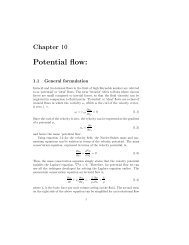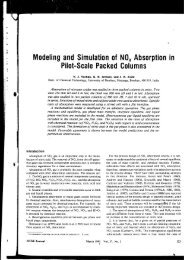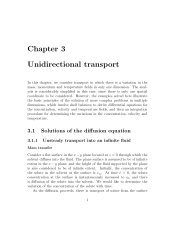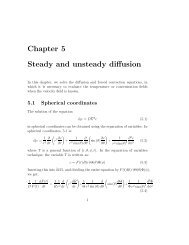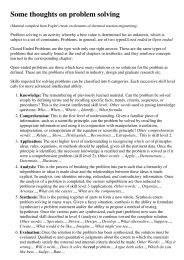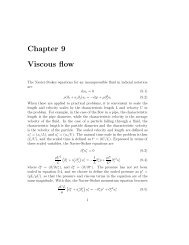Chapter 11 Boundary layer theory
Chapter 11 Boundary layer theory
Chapter 11 Boundary layer theory
You also want an ePaper? Increase the reach of your titles
YUMPU automatically turns print PDFs into web optimized ePapers that Google loves.
<strong>11</strong>.2. FALKNER-SKAN SOLUTIONS 13<br />
location p(x, y) = p ∞ (x), and the pressure gradient in the x direction is,<br />
∂p<br />
∂x = ∂p ∞ dU<br />
= −ρU (<strong>11</strong>.65)<br />
∂x dx<br />
When this is inserted into the momentum conservation equation <strong>11</strong>.19, we<br />
obtain, (<br />
)<br />
∂u x<br />
ρ u x<br />
∂x + u ∂u x<br />
y = ρU ∂U<br />
∂y ∂x + u x<br />
µ∂2 (<strong>11</strong>.66)<br />
∂y 2<br />
The boundary conditions at the surface of are given by <strong>11</strong>.3 and <strong>11</strong>.4,<br />
u x = 0 at y = 0 (<strong>11</strong>.67)<br />
u y = 0 at y = 0 (<strong>11</strong>.68)<br />
while the boundary condition in the limit y → ∞ is given by equation <strong>11</strong>.5.<br />
u x = U(x) for y → ∞ (<strong>11</strong>.69)<br />
The fluid velocity and pressure fields are governed by equations <strong>11</strong>.9,<br />
<strong>11</strong>.20 and <strong>11</strong>.66. We assume that the solution can be expressed in terms of a<br />
similarity variable η = (y/δ(x)), where the boundary <strong>layer</strong> thickness δ(x) is a<br />
function of x. Note that δ(x) ≪ L in the high Reynolds number limit, where<br />
L is the characteristic length scale of the flow. The form for the velocity u x<br />
is chosen to be,<br />
u x = U(x) df<br />
(<strong>11</strong>.70)<br />
dη<br />
Note that this is of the same form as that for the flow past a flat plate in<br />
equation <strong>11</strong>.27, and for the stagnation point flow in equation <strong>11</strong>.49 where<br />
U(x) = ˙γx. The stream function can be obtained by integrating equation<br />
<strong>11</strong>.70 with respect to y,<br />
ψ =<br />
∫ y<br />
The velocity u y in the y direction is,<br />
u y<br />
= − ∂ψ<br />
∂x<br />
0<br />
dy u x<br />
∫ η<br />
= δ(x)U(x) dη ′ df<br />
0 dη<br />
= δ(x)U(x)f(η) (<strong>11</strong>.71)<br />
= − d(δ(x)U(x)) f(η) + U(x)y dδ(x)<br />
dx δ(x) 2 dx<br />
df<br />
dη<br />
(<strong>11</strong>.72)





